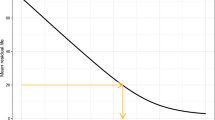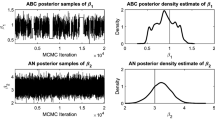Abstract
For the first time, we propose a flexible cure rate survival model by assuming that the number of competing causes of the event of interest follows the Neyman type A distribution and the time to this event has the beta Weibull distribution. This new model can be used to analyze survival data when the hazard rate function is increasing, decreasing, bathtub or unimodal-shaped. It includes some commonly used lifetime distributions and some well-known cure rate models as special cases. Maximum likelihood and non-parametric bootstrap are used to estimate the regression parameters. We derive the appropriate matrices for assessing local influence on the parameter estimates under different perturbation schemes and present some ways to perform global influence analysis. The usefulness of the new model is illustrated by means of an application in the medical area.






Similar content being viewed by others
References
Bhalerao NR, Gurland J, Tripathi RC (1980) A method of increasing power of a test for the negative binomial and Neyman type A distributions. J Am Stat Assoc 75:934–938
Barton DE (1957) The modality of Neyman’s contagious distribution of type A. Trabajos de Estadística 8:13–22
Berkson J, Gage RP (1952) Survival curve for cancer patients following treatment. J Am Stat Assoc 88:1412–1418
Boag J (1949) Maximum likelihood estimates of the proportion of patients cured by cancer therapy. J R Stat Soc Ser B 11:15–44
Cordeiro GM, Nadarajah S, Ortega EMM (2010) General results for the beta Weibull distribution. J Stat Comput Simul. doi:10.1080/00949655.2011.649756
Chen MH, Ibrahim JG, Sinha D (1999) A new Bayesian model for survival data with a surviving fraction. J Am Stat Assoc 94:909–919
Cook RD (1986) Assessment of local influence (with discussion). J R Stat Soc 48:133–169
David FN, Moore PG (1954) Notes on contagious distributions in plant populations. Ann Bot New Ser 18:47–53
Davison AC, Hinkley DV (1997) Bootstrap methods and their application. Cambridge University Press, New York
de Castro M, Cancho VG, Rodrigues J (2009) A bayesian long-term survival model parametrized in the cured fraction. Biom J 51:443–455
DiCiccio TJ, Efron B (1996) Bootstrap confidence intervals. Stat Sci 11:189–228
Dobbie MJ, Welsh AH (2001) Models for zero-inflated count data using the Neyman type A distribution. Stat Model 1:65–80
Doornik JA (2007) An object-oriented matrix language Ox 5. Timberlake Consultants Press, London
Efron B (1979) Bootstrap methods: another look at the jackknife. Ann Stat 7:1–26
Efron B, Tibshirani RJ (1993) An introduction to the bootstrap. Chapman& Hall, New York
Fachini JB, Ortega EMM, Louzada-Neto F (2008) Influence diagnostics for polyhazard models in the presence of covariates. Stat Methods Appl 17:413–433
Famoye F, Lee C, Olumolade O (2005) The beta-Weibull distribution. J Stat Theory Appl 4:121–136
Gupta RD, Kundu D (1999) Generalized exponential distributions. Aust NZ J Stat 41:173–188
Hashimoto EM, Ortega EMM, Cancho VG, Cordeiro GM (2010) The log-exponentiated Weibull regression model for interval-censored data. Comput Stat Data Anal 54:1017–1035
Hashimoto EM, Ortega EMM, Paula GA, Barreto ML (2011) Regression models for grouped survival data: estimation and sensitivity analysis. Comput Stat Data Anal 55:993–1007
Heilbron DC (1994) Zero-altered and other regression models for count data with added zeros. Biom J 36:531–547
Ibrahim JG, Chen MH, Sinha D (2001) Bayesian survival analysis. Springer, New York
Ibrahim JG, Zhu HT, Tang NS (2011) Bayesian local influence for survival models (with discussion). Lifetime Data Anal 17:43–70
Johnson NL, Kemp AW, Kotz S (2005) Univariate discrete distributions. Wiley, New Jersey
Kundu D, Raqab MZ (2005) Generalized Rayleigh distribution: different methods of estimation. Comput Stat Data Anal 49:187–200
Lai CD, Xie M, Murthy DNP (2003) A modified Weibull distribution. Trans Reliab 52:33–37
Lawless JF (2003) Statistical models and methods for lifetime data. Wiley, New York
Lee C, Famoye F, Olumolade O (2007) Beta-Weibull distribution: some properties and applications to censored data. J Modern Appl Stat Methods 6:173–186
Mudholkar GS, Srivastava DK, Friemer M (1995) The exponentiated Weibull family: a reanalysis of the bus-motor-failure data. Technometrics 37:436–445
Nadarajah S, Kotz S (2006) The beta exponential distribution. Reliab Eng Syst Saf 91:689–697
Neyman J (1939) On a new class of contagious distributions applicable in entomology and bacteriology. Ann Math Stat 10:35–57
Ortega EMM, Cancho VG, Bolfarine H (2006) Influence diagnostics in exponentiated-Weibull regression models with censored data. Stat Oper Res Trans 30:171–192
Ortega EMM, Cancho VG, Paula GA (2009) Generalized log-gamma regression models with cure fraction. Lifetime Data Anal 15:79–106
Ortega EMM, Cordeiro GM, Carrasco JMF (2011) The log-generalized modified Weibull regression model. Braz J Probab Stat 25:64–89
Rodrigues J, Cancho VG, de Castro M, Louzada-Neto F (2009) On the unification of the long-term survival models. Stat Probab Lett 79:753–759
Shenton LR (1949) On the efficiency of the method of moments and Neyman’s type A distribution. Biometrika 36:450–454
Silva GO, Ortega EMM, Garibay VC, Barreto ML (2008) Log-Burr XII regression models with censored data. Comput Stat Data Anal 52:3820–3842
Silva GO, Ortega EMM, Garibay VC (2010a) Log-Weibull extended regression model: estimation, sensitivity and residual analysis. Stat Methodol 7:614–631
Silva GO, Ortega EMM, Cordeiro GM (2010b) The beta modified Weibull distribution. Lifetime Data Anal 16:409–430
Sy JP, Taylor JMG (2000) Estimation in a Cox proportional hazards cure model. Biometrics 56:227–236
Tsodikov AD, Ibrahim JG, Yakovlev AY (2003) Estimating cure rates from survival data: an alternative to two-component mixture models. J Am Stat Assoc 98:1063–1078
Wang P, Puterman M, Cockburn I, Le N (1996) Mixed Poisson regression models with covariates dependent rates. Biometrics 52:381–400
Yakovlev A, Tsodikov AD (1996) Stochastic models of tumor latency and their biostatistical applications. Mathematical biology and medicine, vol 1. World Scientific, New Jersey.
Yu M, Law NJ, Taylor JMG, Sandler HM (2004) Joint lonfitudinal-survival-cure models and their application to prostate cancer. Stat Sinica 14:835–862
Yu B, Tiwari RC (2007) Application of EM algorithm to mixture cure model for grouped relative survival data. J Data Sci 5:41–51
Xie M, Lai CD (1995) Reliability analysis using an additive Weibull model with bathtub-shaped failure rate function. Reliab Eng Syst Saf 52:87–93
Xie FC, Wei BC (2007) Diagnostics analysis in censored generalized Poisson regression model. J Stat Comput Simul 77:695–708
Zhu H, Zhang H (2004) A diagnostic procedure based on local influence. Biometrika 91:579–589
Zhu H, Ibrahim JG, Lee S, Zhang H (2007) Peturbation selection and influence measures in local influence analysis. Ann Stat 35:2565–2588
Acknowledgments
This study was supported by FAPESP (Grant 2010/04496-2) and CNPq, Brazil.The authors would like to thank the editor and two anonymous referees for helpful comments on a previous draft.
Author information
Authors and Affiliations
Corresponding author
Appendix A: Matrix of second derivatives \(\ddot{{\mathbf L}}(\varvec{\theta })\)
Appendix A: Matrix of second derivatives \(\ddot{{\mathbf L}}(\varvec{\theta })\)
Here, we derive the formulae to obtain the second-order partial derivatives of the log-likelihood function. After some algebraic manipulations, we obtain
where \(f(t_i)\) and \(F(t_i)\) are defined in (2) and (3), respectively,
for \(i=1,\ldots ,n\); \(q,r=1,\ldots ,4\,\) and \(\,j,s=1,\ldots ,k\).
Rights and permissions
About this article
Cite this article
Hashimoto, E.M., Cordeiro, G.M. & Ortega, E.M.M. The new Neyman type A beta Weibull model with long-term survivors. Comput Stat 28, 933–954 (2013). https://doi.org/10.1007/s00180-012-0338-9
Received:
Accepted:
Published:
Issue Date:
DOI: https://doi.org/10.1007/s00180-012-0338-9




